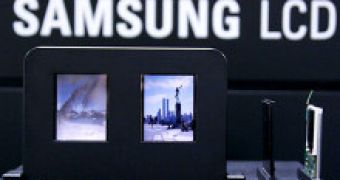Samsung Electronics announced that it has developed the first LCD panel that can display independent images on each side of a mobile LCD screen. Samsung's new double-sided LCD can show two entirely different pictures or sets of visual data simultaneously on the front and back of the same screen. Other conventional double-sided LCDs can only show a reverse image of the same video data. This new technology will allow the replacement of two display panels with one, resulting in a reduced overall thickness of mobile products by at least 1 mm.
The new LCD product uses Samsung's new double-gate, thin-film transistor (TFT) architecture. TFT gates are electronic components that convert the necessary voltage at the pixel level, which controls the liquid crystal alignment needed to reproduce on-screen images. Samsung's new double-sided LCD has two gates that operate each pixel instead of one, so the screen on the front can display different images than the one on the back. The double-sided display makes use of Samsung's proprietary Amorphous Silicon Gate (ASG) technology, which accommodates the increased number of TFT gates without increasing the size of the driver integrated circuits. Driver-ICs typically increase in size when more TFT gates are used.
The new Samsung mobile display requires only one backlight, while competitive double-screen LCDs require two. One side of the panel operates in a transmissive mode, while the other operates in a reflective mode. By using a unique reflective design that utilizes the light trapped in the opposing screen's transmissive mode, the reflective mode does not solely rely on external light sources such as the sun. The double-sided, dual image LCD's efficient use of light to display images in both transmissive and reflective modes promotes slimmer, more cost-effective products.
The new double-sided LCD, which has a thickness of 2.6 mm and is 2.22 inches wide, can display a 240 x 320 pixel resolution, and has brightness values of 250 nits for the front and 100 nits for the rear display. It will be exhibited at the Consumer Electronics Show, which opens in Las Vegas on January 8.

 14 DAY TRIAL //
14 DAY TRIAL //